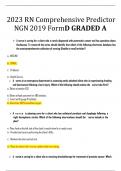Stress - 3 stages of Selye’s General Adaptation Syndrome
Alarm-fight or flight response due to stressful stimulus Resistance – Allostasis Exhaustion- allostatic overload/disease
- role of hypothalamus and function of corticotropin releasing hormone
Hypothalamus senses stressor and release corticotropin releasing hormone which then causes the adrenal medulla to release catecholamines (epinephrine and norepinephrine) - role of anterior pituitary and function of adrenocorticotropic hormone (ACTH)
Anterior pituitary secretes adrenocorticotropic hormone and adrenal cortex secretes glucocorticoids (cortisol and aldosterone)
- role of posterior pituitary and function of antidiuretic hormone/vasopressin (ADH)
Posterior pituitary releases ADH- which causes water to be reabsorbed, increases blood volume and BP
- role of adrenal glands and functions of catecholamines and corticosteroids
Play an integral role in allostasis, sympathico-adrenal system response mediates the fight or flight response
Norepinephrine-constricts blood vessels, raises BP , reduces gastric secretions, increases night/far vision
Epinephrine-enhances myocardial contractility, increases heart rate, increases cardiac output, causes bronchodilation, increases release of glucose from the liver (glycogenolysis) and elevate glucose levels.
-corticosteriods-cortisol, aldosterone
Critical to maintenance of homeostasis, may energize or antagonize effects of catecholamines
Cortisol-primary glucocorticoid, affects protein metabolism, promotes appetite and food seeking behavior, has anti-inflammatory effects
Aldosterone-primary mineralcorticoid, promotes reabsorption of sodium and water, increases blood pressure
- functions of endorphins/enkephalins and immune cytokines
Endogenous opioids (body’s natural pain relievers) raise pain threshold, produce sedation and euphoria.
Immune cytokines
Secreted by macrophages during stress response. Enhance immune system response, prolonged
stress can suppress immune functioning. Example interlukin-1.
- allostatic overload Results in inability to maintain homeostasis, leads to various illnesses and disorders, both physical and emotional
- explain why each of the following can occur due to stress: Hypertension-epinephrine increases BP
Stroke-increases in BP
Coronary Artery Disease- increases in BP
Gastrointestinal Problems- norepi-vasoconstriction
Immune suppression- cortisol-decreases inflammatory response/immune response
Diabetes Mellitus - cortisol and epi increase blood glucose
Which is a true statement regarding cortisol?
It produces stress response effects similar to those of epinephrine.
Its activity is shorter than that of epinephrine.
It has no known effect on the immune system.
It is associated with the alarm stage.
Which cardiovascular disorder has not been linked to excessive catecholamine levels in the blood?
Stroke
Hypertension
Myocardial Infarction
Heart valve dysfunction
Which statement is true regarding epinephrine?
It has the exact same effects as norepinephrine.
It causes a decrease in glycogenolysis.
It causes a decrease in muscle strength.
It results in increased cardiac output.
What stage is defined by “fight or flight”?
Alarm
Resistance
Exhaustion
Adaptation
Which is true regarding catecholamines?
They are from the parasympathetic nervous system.
They include epinephrine and norepinephrine.
They cross the blood-brain barrier.
They cause a decrease in heart rate.
------------------------------------------------------------------------------------------------------------------------------- Anemia - description
Deficit of red cells
Low oxygen-carrying capacity leads to hypoxia
Relative anemia—normal total red cell mass with disturbances in regulation of plasma volume
Absolute anemia—actual decrease in numbers of red cells
Decreased production
Increased destruction
- general effects
Reduction in oxygen-carrying capacity
Tissue hypoxia
Compensatory mechanism to restore tissue oxygenation
Increased heart rate, cardiac output, circulatory rate, and flow to vital organs
Increase in 2,3-DPG in erythrocytes and decreased oxygen affinity of hemoglobin in tissues
Increase in erythropoietin activity
- signs/symptoms of mild, moderate, and severe anemia
Mild anemia Usually no clinical symptoms
Elderly with cardiovascular, pulmonary disease may have symptoms
Mild to moderate anemia
Fatigue, generalized weakness, and loss of stamina, followed by tachycardia and exertional dyspnea
Moderate to severe anemia
Orthostatic and generalized hypotension, vasoconstriction, pallor
Tachypnea, dyspnea
Tachycardia, transient murmurs, angina pectoris, heart failure
Intermittent claudication, night cramps in muscles
Headache, lightheadedness and faintness
Tinnitus, roaring in the ears
- compare/contrast aplastic, Vitamin B deficiency, iron deficiency, and sickle-cell in terms of: causes, signs/symptoms, lab results, treatment, prognosis Aplastic Anemia
˜ Stem cell disorder characterized by reduction of hematopoietic tissue, fatty marrow replacement, and pancytopenia (low RBC, WBC, and platelets)
˜Caused by toxic, radiant, or immunologic injury to the bone marrow stem cells
˜Diagnosed with bone marrow biopsy ˜Disease of the young (15-25) or old (>60)
can occur due to chemotherapy
˜Insidious onset of symptoms
˜Late symptoms include weakness, fatigue, lethargy, pallor, dyspnea, palpitations, transient



